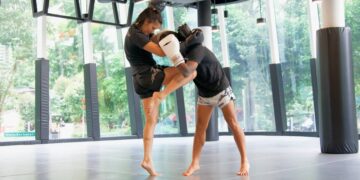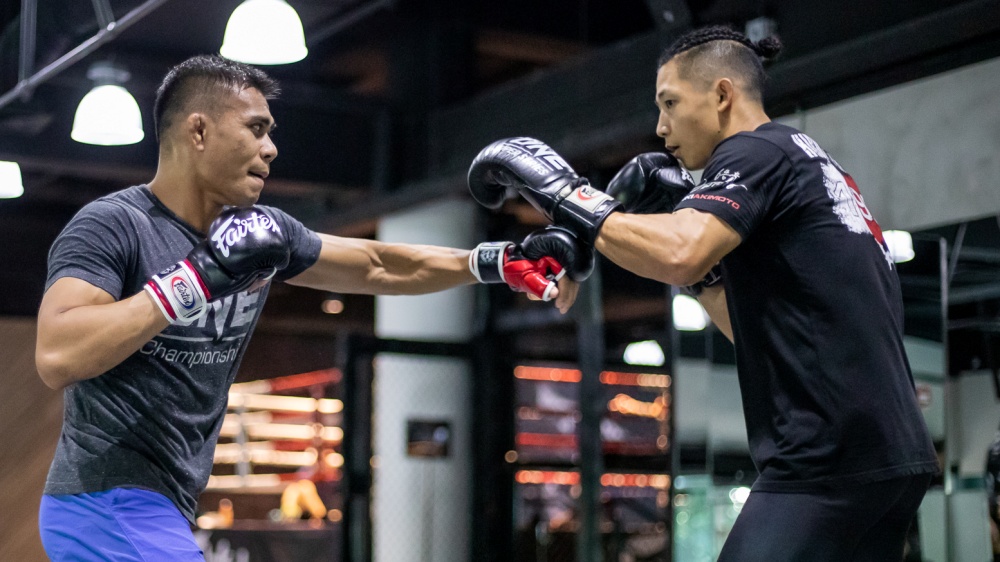In the world of Mixed Martial Arts (MMA), sparring is an integral and dynamic component of combat sports training, serving as a bridge between technique practice and fight application. Sparring is a controlled environment where practitioners can test their skills, refine their techniques, and gain practical experience in a simulated combat scenario. Sparring plays a crucial role in developing a fighter’s instincts, adaptability, and strategic thinking, while also providing an avenue for physical conditioning and mental resilience.
Sparring takes on a unique significance due to the sport’s multifaceted nature. MMA encompasses a wide range of techniques, including striking, grappling, clinching, and submission holds, all of which come together to form a fluid and complex fighting style.
MMA sparring involves not only the exchange of strikes but also transitions between different ranges of combat. This diversity challenges fighters to seamlessly switch between striking combinations, takedowns, clinches, and ground-based techniques, emphasizing the need for versatility and strategic planning.
MMA sparring sessions are meticulously designed to mimic the unpredictable nature of an actual MMA fight while maintaining a safe and controlled environment. Fighters wear appropriate protective gear, such as gloves, mouthguards, and sometimes headgear, to train safely and effectively before actual fights.
The aim is not to inflict harm on your sparring but to challenge each other’s skills and tactics while adhering to the principles of respect and sportsmanship. Through sparring, MMA fighters can learn to manage their energy levels, make split-second decisions, and adapt to various opponents’ styles – all essential attributes for success in the fast-paced and ever-evolving world of MMA.
Furthermore, MMA sparring isn’t just a physical exercise; it’s mental and emotional as well. It requires fighters to stay composed under pressure, manage adrenaline, and maintain a clear mind while facing an opponent who is actively trying to outmaneuver them. This mental resilience gained from sparring translates to the octagon, where fighters must navigate the highs and lows of a real fight.
MMA (Mixed Martial Arts) sparring can be an effective and crucial component of your training regimen, but it’s important to approach it with caution and respect to ensure safety and skill development.
Do’s And Don’ts
Here are some do’s and don’ts for MMA sparring:
Do’s:
- Warm-Up: Always start with a proper warm-up to prepare your body for the physical demands of sparring. This helps prevent injuries.
- Use Protective Gear: Wear appropriate protective gear, including mouthguards, gloves, shin guards, and headgear. This will help minimize the risk of injuries.
- Communicate: Before starting, communicate with your training partner about the intensity and goals of the sparring session. Make sure you both are on the same page regarding the level of contact and techniques you’ll be using.
- Start Slowly: Begin with light and controlled sparring to warm up and get a feel for your partner’s movements and techniques.
- Focus On Technique: Use sparring as an opportunity to practice and refine your techniques. Focus on proper form, footwork, and defensive skills.
- Control Power: Gradually increase the power and intensity of your strikes as you both become more comfortable during the session. It’s crucial to maintain control and avoid reckless aggression.
- Practice Different Ranges: MMA involves various ranges of combat, such as striking, clinching, and grappling. Use sparring sessions to practice transitions between these ranges.
- Mix It Up: Incorporate a variety of techniques, strategies, and combinations to keep your sparring partner guessing and to simulate real fight scenarios.
- Stay Relaxed: Try to stay relaxed during sparring. Tension can lead to fatigue and decreased performance. Focus on breathing and staying composed.
- Tap Early: If you get caught in a submission or a joint lock, tap out early. It’s better to tap and learn than risk unnecessary harm.
Don’ts:
- Don’t Go All-Out: Avoid going all-out in sparring, especially with beginners. It’s a training session, not a fight. Prioritize controlled practice over trying to “win.”
- Don’t Target the Head: Limit head strikes, especially without headgear. While MMA does involve striking to the head, excessive and hard shots can cause concussions and long-term damage.
- Don’t Ego Spar: Leave your ego at the door. Sparring is about improvement and learning, not proving your dominance.
- Don’t Be Overly Aggressive: While it’s essential to be assertive, being overly aggressive can lead to injuries and create a negative training environment.
- Don’t Neglect Defense: Defense is as important as offense. Focus on avoiding strikes and controlling your opponent’s attacks.
- Don’t Disregard Takedowns and Submissions: Incorporate takedowns and submissions into your sparring sessions to practice well-rounded MMA skills.
- Don’t Mock or Taunt: Show respect to your training partners. Taunting or mocking can escalate situations and create unnecessary tension.
- Don’t Neglect Recovery: After sparring, cool down properly, stretch, and take care of any injuries or soreness.
- Don’t Skip Hydration: Stay hydrated throughout the session to maintain your performance and prevent fatigue.
- Don’t Ignore Coaching: If you have a coach or instructor present, listen to their advice and corrections. They can help you improve your skills and techniques.
In conclusion, MMA sparring stands as a vital cornerstone of a fighter’s journey, offering a controlled arena for growth, experimentation, and adaptation. By engaging in purposeful and respectful sparring, MMA practitioners forge their skills, develop an acute sense of timing, and foster the mental fortitude required to excel in the multifaceted world of mixed martial arts.
Remember that the primary goal of MMA sparring is to improve your skills, test your techniques in a dynamic setting, and stay safe. Always prioritize safety, respect, and learning over aggression or winning during sparring sessions.
You may also like:
BJJ Vs MMA Grappling: Similarities And Differences
10 Fighting Tips To Improve Your Performance Inside The Ring
Southpaws have become more prominent in recent years in MMA and other combat sports. Many right-handed fighters are adopting a southpaw stance to utilize the southpaw advantage in their fights. The southpaw advantage is essentially…
Combat sports like Boxing, Muay Thai, and Kickboxing are more cerebral than most people think. Yes, physical attributes like power, speed, and explosiveness go a long way, but what happens when these things cancel out?…
Brazilian Jiu-Jitsu became one of the top martial arts worldwide, thanks to how effective the style proved to be during the early days of mixed martial arts. MMA has since evolved into a unique fighting…
Strength training is an essential part of any fighter’s training regimen. Many MMA fighters use Olympic-style weightlifting to build muscle and improve the connection between their mind and body. However, tendon strength is often overlooked,…
Shadowboxing is one of the most important training tools you have at your disposal when training in martial arts like Boxing, Muay Thai, and Kickboxing. It improves the form of your techniques while increasing your…
The fear of getting hit can leave fighters at any level frozen. It turns them into breathing punching bags as their fear cripples their ability to mount any semblance of an effective offense. Being afraid…
In the fast-paced society that we live in, it’s often easier to reach for convenient but unhealthy food options—think fast food, sugary drinks, and overly processed snacks. However, given the rise of health-consciousness and a…
MAJOR NEWS ALERT! You ask and we deliver! We’re thrilled to elevate your training experience at Evolve MMA. Prepare for an extraordinary series of seminars featuring not one, but SIX World Champions and Superstars from…
One of the slickest techniques in boxing or any combat sports is the boxing shoeshine. When done correctly, it looks as though an invisible shoe is being shined at warp speed. It has been practiced…
The sport of Brazilian Jiu-Jitsu is an ever-evolving martial art that can be as diverse as the practitioners training it. One of the beautiful things about this art is the fact that you can develop…
In the world of Muay Thai, counter fighters are revered for their exceptional defensive prowess and impeccable timing. Some of these skilled practitioners possess the ability to exploit their opponent’s mistakes and capitalize on openings…
The Estima Lock, named after Brazilian Jiu-Jitsu practitioners and brothers Victor and Braulio Estima, is a unique and absolutely nasty foot lock submission. It targets the opponent’s foot, specifically the ankle, and can be applied…



































